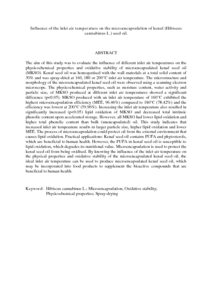Citation
Ng, Shy Kai and Wong, Pui Yee and Tan, Chin Ping and Long, Kamariah and Nyam, Kar Lin
(2013)
Influence of the inlet air temperature on the microencapsulation of kenaf (Hibiscus cannabinus L.) seed oil.
European Journal of Lipid Science and Technology, 115 (11).
pp. 1309-1318.
ISSN 1438-7697; ESSN: 1438-9312
Abstract
The aim of this study was to evaluate the influence of different inlet air temperatures on the physicochemical properties and oxidative stability of microencapsulated kenaf seed oil (MKSO). Kenaf seed oil was homogenised with the wall materials at a total solid content of 30% and was spray-dried at 160, 180 or 200°C inlet air temperature. The microstructure and morphology of the microencapsulated kenaf seed oil were observed using a scanning electron microscope. The physicochemical properties, such as moisture content, water activity and particle size, of MKSO produced at different inlet air temperatures showed a significant difference (p<0.05). MKSO produced with an inlet air temperature of 160°C exhibited the highest microencapsulation efficiency (MEE, 96.46%) compared to 180°C (78.42%) and the efficiency was lowest at 200°C (58.96%). Increasing the inlet air temperature also resulted in significantly increased (p<0.05) lipid oxidation of MKSO and decreased total intrinsic phenolic content upon accelerated storage. However, all MKSO had lower lipid oxidation and higher total phenolic content than bulk (unencapsulated) oil. This study indicates that increased inlet air temperature results in larger particle size, higher lipid oxidation and lower MEE. The process of microencapsulation could protect oil from the external environment that causes lipid oxidation.
Practical applications: Kenaf seed oil contains PUFA and phytosterols, which are beneficial to human health. However, the PUFA in kenaf seed oil is susceptible to lipid oxidation, which degrades its nutritional value. Microencapsulation is used to protect the kenaf seed oil from being oxidised. By knowing the influence of the inlet air temperature on the physical properties and oxidative stability of the microencapsulated kenaf seed oil, the ideal inlet air temperature can be used to produce microencapsulated kenaf seed oil, which may be incorporated into food products to supplement the bioactive compounds that are beneficial to human health.
Download File
![[img]](http://psasir.upm.edu.my/30482/1.hassmallThumbnailVersion/Influence%20of%20the%20inlet%20air%20temperature%20on%20the%20microencapsulation%20of%20kenaf.pdf)  Preview |
|
PDF (Abstract)
Influence of the inlet air temperature on the microencapsulation of kenaf.pdf
Download (84kB)
| Preview
|
|
Additional Metadata
Actions (login required)
 |
View Item |

